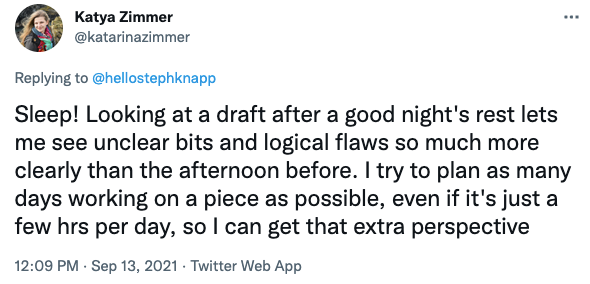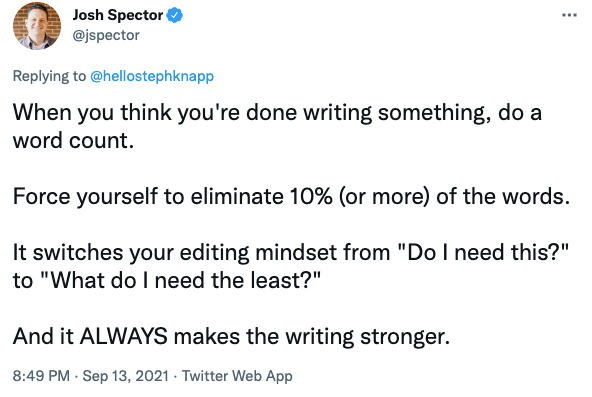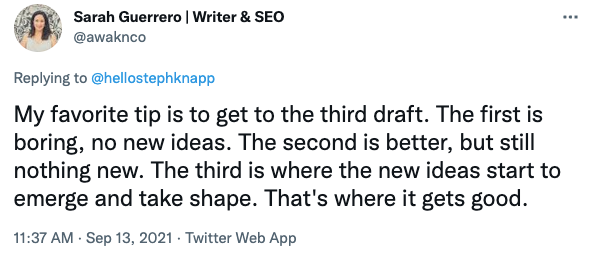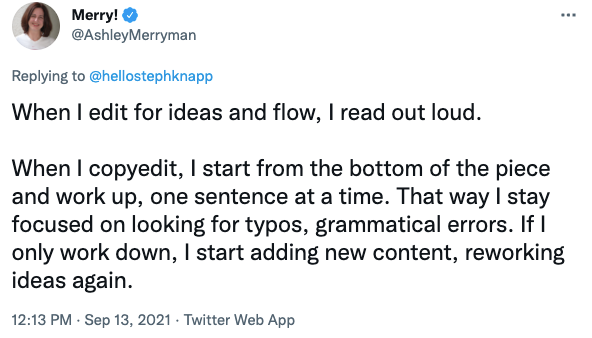Every time we create, we also have to edit.
Unless you have a dedicated editor or coworker to give you an outside perspective, it's possible you'll be the only influence on a piece of marketing. When you're in charge of a piece of writing, no matter how short or long, the weight of getting it right on your own is heavy.
There are ways to self-edit, though. So much so that when I asked fellow marketers and writers to share their tips, there was an outpouring of advice (and I suggest reading through all the tips I received).
Here, I'll share my own five-step self-editing process, and I'll include some of the clever tricks the community shared—which I absolutely plan to start using myself.
1. Wait, if you can
You can't see the whole picture from an inch away. That's why it's always best to wait a day between writing and editing to come back with fresh eyes. At the very least, step away for a walk or lunch break.
The goal is to forget what you assume you wrote, so you can see what you actually put down. Sometimes a piece you hate during writing turns out not to be so bad once you've had time to cool off. I also find walking away makes it easier to catch typos or strange sentence structures.
When I asked marketers for their self-editing tips, sleeping on the draft was by far the most popular response. Ashley R. Cummings, Katya Zimmer, Shivani Shah, Kaitlyn Arford, and more all suggested walking away from a draft.

2. Check the organization
After giving your mind a break, it's best to start your editing from 20,000 feet. Resist the urge to jump into spell-check just yet—you need to make sure this building is structurally sound first.
Consider the objective of your copy or content. What are you trying to achieve with it, and are there key points you absolutely want to hit? Lesley Sim, co-founder of Newsletter Glue, noted that "every piece of writing can only have ONE IDEA. Anything else diffuses the impact of the writing and must be ruthlessly eliminated." You can even consult any content briefs, brand voice style guides, or ad strategies you have—that might help ground you in this bird's-eye-view read-through.
Once vital information is in place, read through the section headers of longer content—whether it's a blog post or the copy of a web page—to ensure the order you present information makes sense. You can do the same thing for short-form copy, but you'll probably review sentence order instead of paragraph or section order.
Amy Knightley, the founder of Savvy Mudder, likes to mix things up during editing. She shared that she "writes a mini thesis statement on the outline for each section. It keeps the flow and the focus. I then edit sections out of order to see if they deliver on that thesis—or did my focus wander."

3. Simplify it
If you're writing on a topic or product positioning point you know a lot about, it's easy to over-explain. Been there, done that. Recognizing your rambling is hard, though. So, while you work on taking Brad Ewin's advice to "form a disturbing hatred of length and complexity," it helps to lean on a few tools to get the job done:
A free text-to-speech reader lets you listen to your writing. If I'm not careful, I find that I'll read the piece as I intended its meaning, not how it turned out. Hearing the content lets you pinpoint the spots where you drone on or get confusing. Reading your words out loud (or having them read back to you) was a popular piece of advice from Amna Aslam, John Jaehnig, Wendy Jacobson, and others. Zapier writer Justin Pot uses this tactic to catch typos too.
The Hemingway Editor will seek out your hard-to-read sentences. When I use this tool, I try to find the line between simplifying based on recommendations and stripping the piece of personality—make sure it still sounds like you.
Use Ctrl+F (or command+F) to find filler words that complicate your writing. After changing "in order to" to "to" about 100 times, I think I'm finally starting to get the hang of it. But don't only rely on standard word lists to make this happen. Deb Tennen, Managing Editor of the Zapier blog, suggests having your own list of the unnecessary words and phrases you know you use and taking an ax to them when you're done with your draft.

4. Get a diverse perspective
If your team members don't have time to edit your entire piece, find a few points you're unsure of and work across departments to get insights. When I was working on a post for Hotjar, for example, I sent questions to a Senior Product Manager to get tips and definitions that were out of my area of expertise.
For the times you're truly on your own, try to pinpoint any assumptions you've worked into the writing. Have you defined all the acronyms? Are you leaving out information readers need to understand fully? And don't forget to fact-check yourself.
Ryan Law, the Director of Marketing at Animalz, recommends using a "steel man" argument. He shared: "If you were tasked with discrediting your first draft, where would you pick holes? Look for points that need stronger evidence, logical inconsistencies in your argument, areas that feel under- or over-developed."
Another way to change your perspective is to alter the environment. Rosemary Egbo, a Content Marketing Manager, suggests viewing the draft on your phone. "You'll see how it appears on mobile since your audience will likely read it on mobile." Tekendra Parmar, Tech Editor at Insider, recommends changing the font before you edit.

5. Get your grammar in order
Spelling and grammar are important, but I leave them for last. Correcting typos on a confusing or unorganized piece of copy isn't the best use of time. Once you've done everything else, though, run a spell-check. I use Grammarly every day: it goes beyond typos and finds places where I use repetitive words or make grammar mistakes.
Even after running a piece through a spell-check of some kind, try to read it through one last time. Sometimes words are spelled correctly, but they're the wrong term altogether. Steve Ryan, an Assistant Professor of Instruction in PR, does his proofreading backward. "Literally word-by-word in reverse. Makes typos and spelling errors stand out," he shared.

There are all sorts of other tools you can use to do this kind of micro-level editing.
Take a look at Zapier's list of AI editing tools.
If you find yourself using the same terms over and over, this big list of words can broaden your vocabulary.
You can use alex to check your writing for insensitive phrases.
Self-editing is a journey
Your writing will never be 100% perfect. Even if it feels like it is when you hit publish, chances are you'll come back to it down the road and find things you'd like to change. The best thing you can do is to learn your writing weak points and actively check for them in your drafts.
It also helps to remember that even on a small team, you're not alone. If you work in a niche or have a specific question, chances are you can find a community to help you out. You just have to ask!





